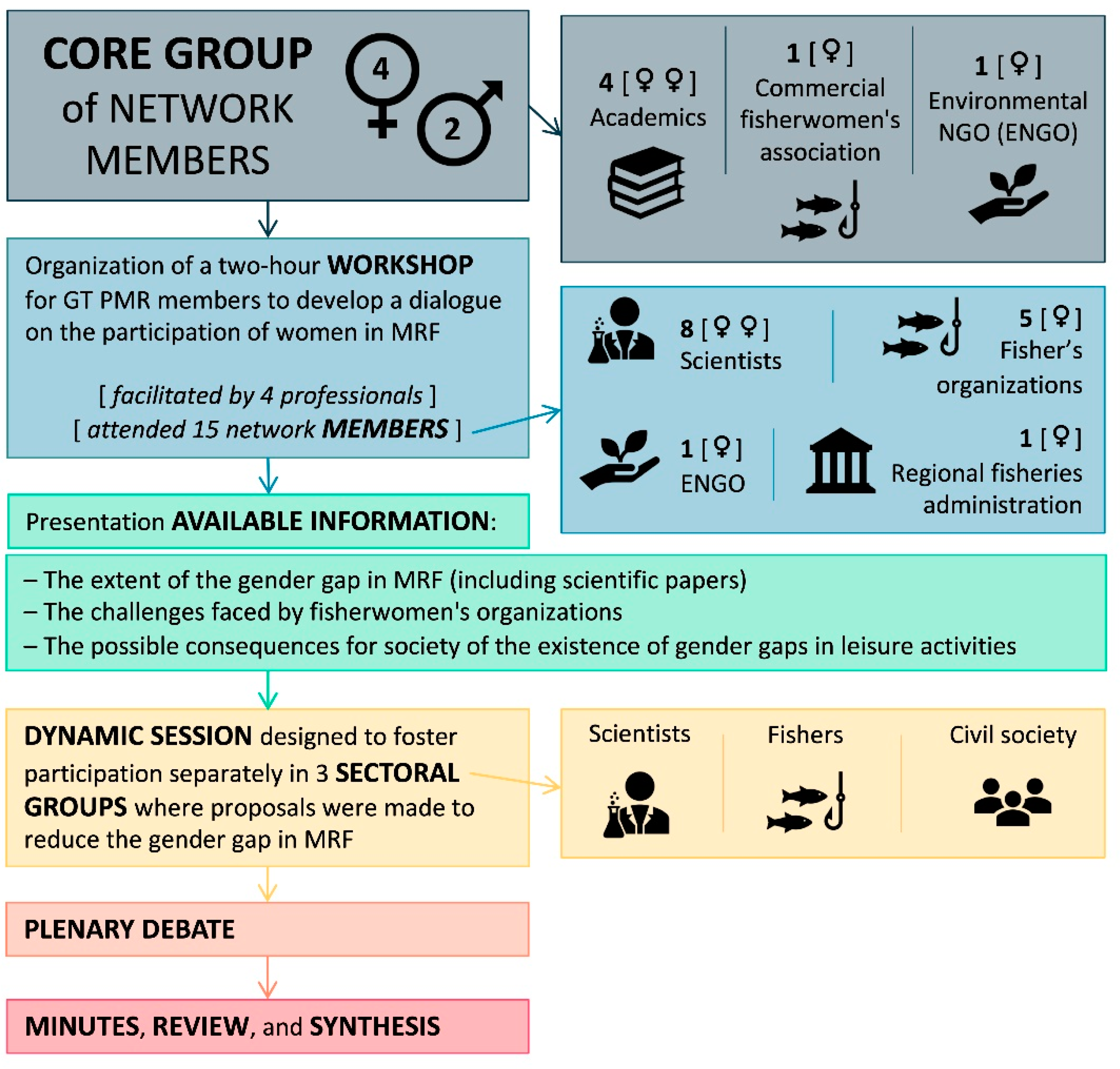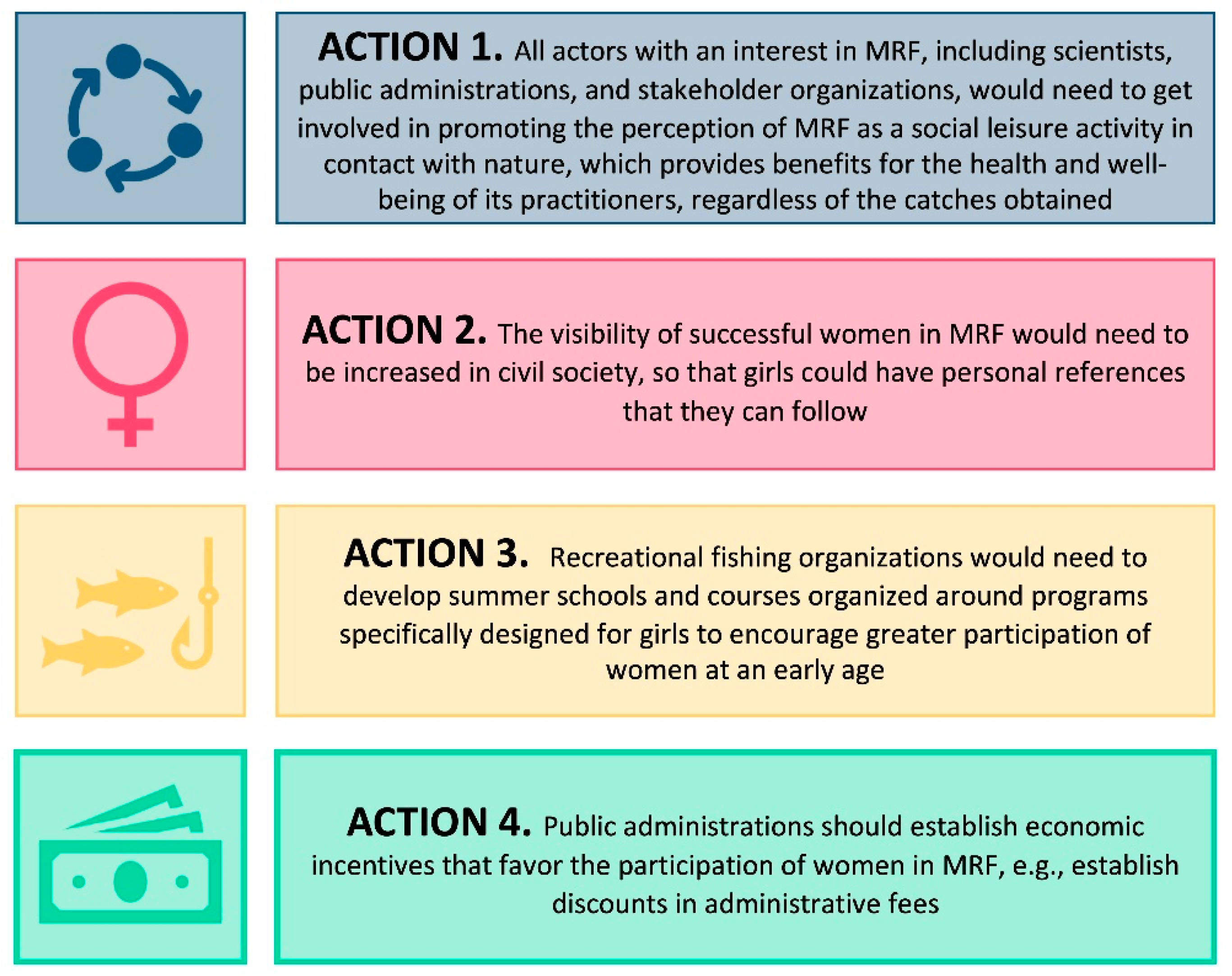Mind the Gender Gap in Marine Recreational Fisheries
Abstract
1. Introduction
2. Methods
3. Results
3.1. How Wide Is the Gap?
3.2. Why Mind the Gap?
3.3. A Roadmap to Gender Equality in Recreational Fisheries
4. Discussion
5. Future Directions
Author Contributions
Funding
Institutional Review Board Statement
Informed Consent Statement
Data Availability Statement
Acknowledgments
Conflicts of Interest
References
- Cisneros-Montemayor, A.M.; Sumaila, U.R. A global estimate of benefits from ecosystem-based marine recreation: Potential impacts and implications for management. J. Bioecon. 2010, 12, 245–268. [Google Scholar] [CrossRef]
- Pita, P.; Ainsworth, G.B.; Antelo, M.; Gouveia, L.; Martínez-Escauriaza, R.; Tubío, A.; Villasante, S. Economic contribution and social welfare of recreational charter boat fisheries in the northeast Atlantic: The cases of Galicia (Spain) and Madeira archipelago (Portugal). Front. Mar. Sci. 2022, 9, 939533. [Google Scholar] [CrossRef]
- Brinson, A.A.; Alcalá, A.; Die, D.J.; Shivlani, M. Contrasting socioeconomic indicators for two fisheries that target Atlantic billfish: Southeast Florida recreational charter boats and Venezuelan artisanal gill-netters. Bull. Mar. Sci. 2006, 79, 635–645. [Google Scholar]
- Kadagi, N.I.; Wambiji, N.; Fennessy, S.T.; Allen, M.S.; Ahrens, R.N.M. Challenges and opportunities for sustainable development and management of marine recreational and sport fisheries in the Western Indian Ocean. Mar. Policy 2021, 124, 104351. [Google Scholar] [CrossRef]
- Kadagi, N.I.; Wambiji, N.; Mann, B.; Parker, D.; Daly, R.; Thoya, P.; Rato, D.A.M.; Halafo, J.; Gaspare, L.; Sweke, E.A.; et al. Status and challenges for sustainable billfish fisheries in the Western Indian Ocean. Rev. Fish Biol. Fish. 2022, 32, 1035–1061. [Google Scholar] [CrossRef]
- Campbell, R.A.; Pepperell, J.G.; Davis, T.L.O. Use of charter boat data to infer the annual availability of black marlin, Makaira indica, to the recreational fishery off Cairns, Australia. Mar. Freshw. Res. 2003, 54, 447–457. [Google Scholar] [CrossRef]
- Holdsworth, J.; Saul, P.; Browne, G. Factors affecting striped marlin catch rate in the New Zealand recreational fishery. Mar. Freshw. Res. 2003, 54, 473–481. [Google Scholar] [CrossRef]
- Scheufele, G.; Pascoe, S. Estimation and use of recreational fishing values in management decisions. Ambio 2022, 51, 1275–1286. [Google Scholar] [CrossRef]
- McManus, A.; Newton, W.; Storey, J.; White, J. Identifying the Health and Well-Being Benefits of Recreational Fishing; Centre of Excellence Sceicne Seafood & Health (CESSH): Perth, Australia, 2011. [Google Scholar]
- Pita, P.; Gribble, M.O.; Antelo, M.; Ainsworth, G.; Hyder, K.; van den Bosch, M.; Villasante, S. Recreational fishing, health and well-being: Findings from a cross-sectional survey. Ecosyst. People 2022, 18, 530–546. [Google Scholar] [CrossRef]
- Hyder, K.; Weltersbach, M.S.; Armstrong, M.; Ferter, K.; Townhill, B.; Ahvonen, A.; Arlinghaus, R.; Baikov, A.; Bellanger, M.; Birzaks, J.; et al. Recreational sea fishing in Europe in a global context—Participation rates, fishing effort, expenditure, and implications for monitoring and assessment. Fish Fish. 2018, 19, 225–243. [Google Scholar] [CrossRef]
- Arlinghaus, R.; Cooke, S.J.; Coleman, F.C.; Figueira, W.F.; Ueland, J.S.; Crowder, L.B. Global impact of recreational fisheries. Science 2005, 307, 1561–1563. [Google Scholar] [CrossRef] [PubMed]
- Pita, P.; Ainsworth, G.B.; Alba, B.; Anderson, A.B.; Antelo, M.; Alós, J.; Artetxe, I.; Baudrier, J.; Castro, J.J.; Chicharro, B.; et al. First assessment of the impacts of the COVID-19 pandemic on global marine recreational fisheries. Front. Mar. Sci. 2021, 8, 735741. [Google Scholar] [CrossRef]
- Schroeder, S.A.; Fulton, D.C.; Currie, L.; Goeman, T. He said, she said: Gender and angling specialization, motivations, ethics, and behaviors. Hum. Dimens. Wildl. 2006, 11, 301–315. [Google Scholar] [CrossRef]
- Gaynor, A.; Frawley, J.; Máñez, K.S. ‘Slim female records the same old story’: Newspapers, gender, and recreational fishing in Australia, 1957–2000. Geoforum 2016, 77, 114–123. [Google Scholar] [CrossRef]
- Humberstone, B. The ‘outdoor industry’as social and educational phenomena: Gender and outdoor adventure/education. J. Adventure Educ. Outdoor Learn. 2000, 1, 21–35. [Google Scholar] [CrossRef]
- Colley, K.; Irvine, K.N.; Currie, M. Who benefits from nature? A quantitative intersectional perspective on inequalities in contact with nature and the gender gap outdoors. Landsc. Urban Plan. 2022, 223, 104420. [Google Scholar] [CrossRef]
- Kleiber, D.; Harris, L.M.; Vincent, A.C.J. Gender and small-scale fisheries: A case for counting women and beyond. Fish Fish. 2015, 16, 547–562. [Google Scholar] [CrossRef]
- Béné, C.; Merten, S. Women and fish-for-sex: Transactional sex, HIV/AIDS and gender in African fisheries. World Dev. 2008, 36, 875–899. [Google Scholar] [CrossRef]
- Bennett, E. Gender, fisheries and development. Mar. Policy 2005, 29, 451–459. [Google Scholar] [CrossRef]
- Leisher, C.; Temsah, G.; Booker, F.; Day, M.; Samberg, L.; Prosnitz, D.; Agarwal, B.; Matthews, E.; Roe, D.; Russell, D.; et al. Does the gender composition of forest and fishery management groups affect resource governance and conservation outcomes? A systematic map. Environ. Evid. 2016, 5, 6. [Google Scholar] [CrossRef]
- Fröcklin, S.; de la Torre-Castro, M.; Lindström, L.; Jiddawi, N.S. Fish traders as key actors in fisheries: Gender and adaptive management. Ambio 2013, 42, 951–962. [Google Scholar] [CrossRef] [PubMed]
- Aas, Ø. Global Challenges in Recreational Fisheries; John Wiley & Sons: Hoboken, NJ, USA, 2008; ISBN 0470698144. [Google Scholar]
- Morales-Nin, B.; Arlinghaus, R.; Alós, J. Contrasting the Motivations and Wildlife-Related Value Orientations of Recreational Fishers with Participants of Other Outdoor and Indoor Recreational Activities. Front. Mar. Sci. 2021, 8, 1005. [Google Scholar] [CrossRef]
- Floyd, M.F.; Nicholas, L.; Lee, I.; Lee, J.-H.; Scott, D. Social stratification in recreational fishing participation: Research and policy implications. Leis. Sci. 2006, 28, 351–368. [Google Scholar] [CrossRef]
- Toth, J.F., Jr.; Brown, R.B. Racial and gender meanings of why people participate in recreational fishing. Leis. Sci. 1997, 19, 129–146. [Google Scholar] [CrossRef]
- Fedler, A.J.; Ditton, R.B. Dropping out and dropping in: A study of factors for changing recreational fishing participation. N. Am. J. Fish. Manag. 2001, 21, 283–292. [Google Scholar] [CrossRef]
- UN ECLAC. Implications of Gender Roles in Natural Resource Governance in Latin America and the Caribbean; Economic Commission for Latin America and the Caribbean (ECLAC): Santiago, Chile, 2021. [Google Scholar]
- UN Women. Gender, Peace and Security in Natural Resource Management: Land, Forest and Water Management in the Asia Pacific; UN Women: Bangkok, Thailand, 2022. [Google Scholar]
- Weichselbaumer, D.; Winter-Ebmer, R. A meta-analysis of the international gender wage gap. J. Econ. Surv. 2005, 19, 479–511. [Google Scholar] [CrossRef]
- Ogden, L.E. Fisherwomen—The uncounted dimension in fisheries management: Shedding light on the invisible gender. BioScience 2017, 67, 111–117. [Google Scholar] [CrossRef]
- Davis, D.L.; Nadel-Klein, J. Gender, culture, and the sea: Contemporary theoretical approaches. Soc. Nat. Resour. 1992, 5, 135–147. [Google Scholar] [CrossRef]
- Cordingly, D. Women Sailors and Sailors’ Women; Random House: New York, NY, USA, 2001; ISBN 0375506977. [Google Scholar]
- Frangoudes, K.; Marugán-Pintos, B.; Pascual-Fernandez, J.J. Gender in Galician shell-fisheries: Transforming for governability. In Governability of Fisheries and Aquaculture; Springer: Berlin/Heidelberg, Germany, 2013; pp. 241–261. [Google Scholar]
- Piñeiro-Antelo, M.d.l.Á.; Santos, X.M. Shellfishing on foot and the road to defeminization in Galicia (Spain). Marit. Stud. 2021, 20, 341–354. [Google Scholar] [CrossRef] [PubMed]
- Müller, J.D.S.; Falcão, I.R.; Couto, M.C.B.M.; Viana, W.D.S.; Alves, I.B.; Viola, D.N.; Woods, C.G.; Rêgo, R.F. Health-related quality of life among artisanal fisherwomen/shellfish gatherers: Lower than the general population. Int. J. Environ. Res. Public Health 2016, 13, 466. [Google Scholar] [CrossRef]
- Inglehart, R.; Norris, P.; Welzel, C. Gender equality and democracy. In Human Values and Social Change; Brill: Leiden, The Netherlands, 2003; pp. 91–115. ISBN 904740436X. [Google Scholar]
- International Working Group on Women and Sport. Brighton plus Helsinki Declaration on Women and Sport. In Proceedings of the 6th IWG World Conference on Women and Sport, Helsinki, Finland, 12–15 June 2014; p. 5. [Google Scholar]
- Scott, D.; Shafer, C.S. Recreational specialization: A critical look at the construct. J. Leis. Res. 2001, 33, 319–343. [Google Scholar] [CrossRef]
- Pita, P.; Alós, J.; Antelo, M.; Artetxe, I.; Biton-Porsmoguer, S.; Carreño, A.; Cuadros, A.; Font, T.; Beiro, J.; García-Charton, J.A.; et al. Assessing knowledge gaps and management needs to cope with barriers for environmental, economic and social sustainability of marine recreational fisheries: The case of Spain. Front. Mar. Sci. 2020, 7, 23. [Google Scholar] [CrossRef]
- Bryan, H. Leisure value systems and recreational specialization: The case of trout fishermen. J. Leis. Res. 1977, 9, 174–187. [Google Scholar] [CrossRef]
- Frangoudes, K.; Pascual-Fernandez, J.J.; Marugán-Pintos, B. Women’s Organisations in Fisheries and Aquaculture in Europe: History and Future Propects. In Social Issues in Sustainable Fisheries Management; Urquhart, J., Acott, T., Symes, D., Zhao, M., Eds.; Springer: Dordrecht, The Netherlands, 2014; pp. 215–231. [Google Scholar]
- ANMUPESCA Asociación Nacional de Mujeres de la Pesca. Available online: http://www.anmupesca.org/ (accessed on 6 April 2023).
- DM Associació Catalana de Dones de la Mar. Available online: https://donesdelamar.cat/ (accessed on 6 April 2023).
- IWFA International Women’s Fishing Association. Available online: https://www.iwfa.org/ (accessed on 6 April 2023).
- Burton, L.J. Underrepresentation of women in sport leadership: A review of research. Sport Manag. Rev. 2015, 18, 155–165. [Google Scholar] [CrossRef]
- Piggott, L.V.; Matthews, J.J.K. Gender, leadership, and governance in English national governing bodies of sport: Formal structures, rules, and processes. J. Sport Manag. 2020, 35, 338–351. [Google Scholar] [CrossRef]
- Hargreaves, J.A. Gender on the sports agenda. Int. Rev. Sociol. Sport 1990, 25, 287–307. [Google Scholar] [CrossRef]


Disclaimer/Publisher’s Note: The statements, opinions and data contained in all publications are solely those of the individual author(s) and contributor(s) and not of MDPI and/or the editor(s). MDPI and/or the editor(s) disclaim responsibility for any injury to people or property resulting from any ideas, methods, instructions or products referred to in the content. |
© 2023 by the authors. Licensee MDPI, Basel, Switzerland. This article is an open access article distributed under the terms and conditions of the Creative Commons Attribution (CC BY) license (https://creativecommons.org/licenses/by/4.0/).
Share and Cite
Pita, P.; Ainsworth, G.B.; Alba, B.; Alós, J.; Beiro, J.; Martín-Sosa, P.; Martínez, L.; Marugán-Pintos, B.; Morales-Nin, B.; Mugerza, E.; et al. Mind the Gender Gap in Marine Recreational Fisheries. Sustainability 2023, 15, 11292. https://doi.org/10.3390/su151411292
Pita P, Ainsworth GB, Alba B, Alós J, Beiro J, Martín-Sosa P, Martínez L, Marugán-Pintos B, Morales-Nin B, Mugerza E, et al. Mind the Gender Gap in Marine Recreational Fisheries. Sustainability. 2023; 15(14):11292. https://doi.org/10.3390/su151411292
Chicago/Turabian StylePita, Pablo, Gillian Barbara Ainsworth, Bernardino Alba, Josep Alós, José Beiro, Pablo Martín-Sosa, Llibori Martínez, Begoña Marugán-Pintos, Beatriz Morales-Nin, Estanis Mugerza, and et al. 2023. "Mind the Gender Gap in Marine Recreational Fisheries" Sustainability 15, no. 14: 11292. https://doi.org/10.3390/su151411292
APA StylePita, P., Ainsworth, G. B., Alba, B., Alós, J., Beiro, J., Martín-Sosa, P., Martínez, L., Marugán-Pintos, B., Morales-Nin, B., Mugerza, E., Nieto, B., Seijo, J., Pujol, M., Tubío, A., Venerus, L. A., & Villasante, S. (2023). Mind the Gender Gap in Marine Recreational Fisheries. Sustainability, 15(14), 11292. https://doi.org/10.3390/su151411292







